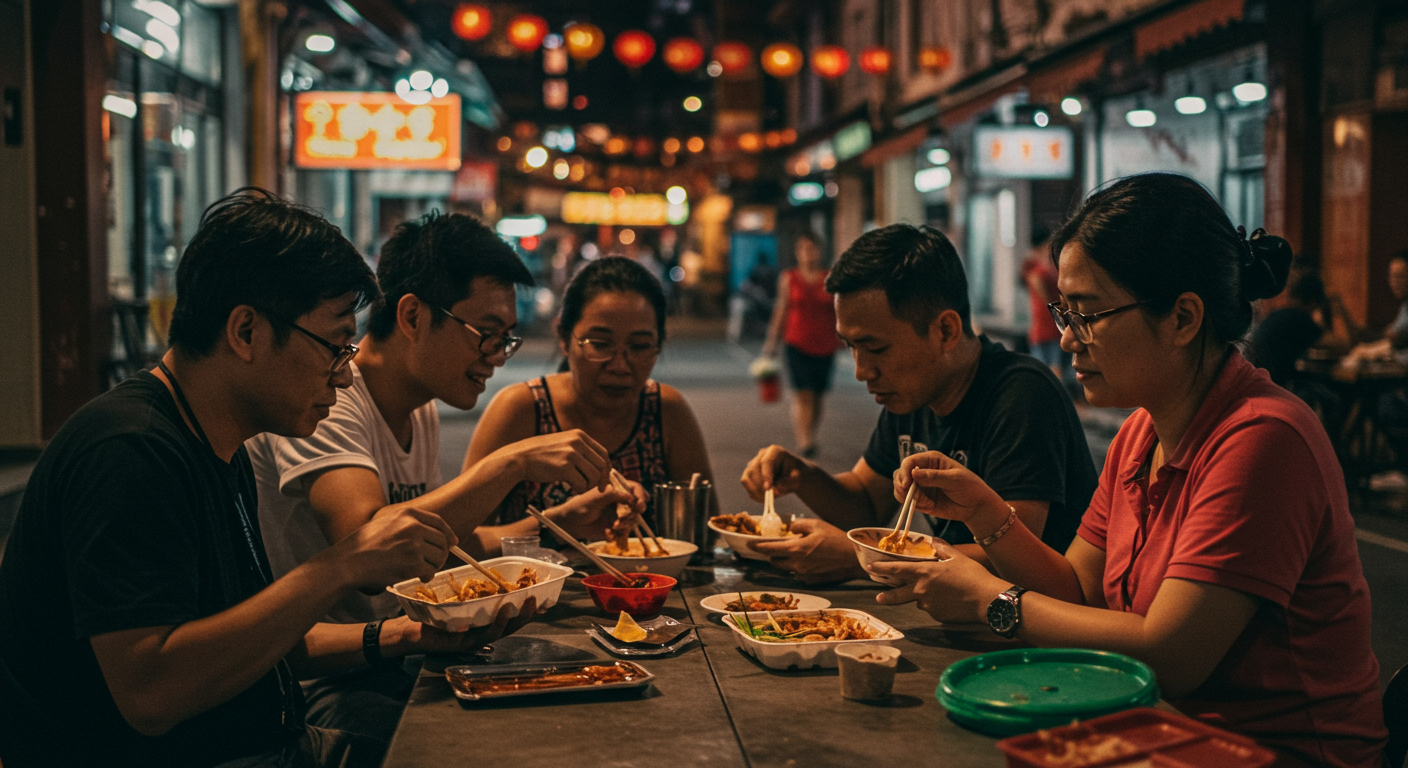Chinatown hawker centres are iconic culinary hubs, especially in places like Singapore, Malaysia, Hong Kong, and other parts of Asia. Known for their vibrant food scenes, affordability, and rich cultural traditions, they attract both locals and tourists. Yet behind the bustling activity and tantalizing aromas, there exists a lesser-known, and sometimes controversial, phenomenon: the consumption of hawker leftovers.
This article explores the practice of Chinatown hawker leftovers consumption, examining the reasons behind it, the people involved, health implications, societal reactions, ethical concerns, and potential solutions.
1. Understanding the Setting: What Are Chinatown Hawker Centres?
Before diving into the issue of leftover consumption, it’s important to understand the cultural and social significance of Chinatown hawker centres.
A Cultural Pillar
Hawker centres in Chinatown are more than just food courts. They are:
-
Cultural melting pots, serving dishes influenced by Chinese, Malay, Indian, and Peranakan traditions.
-
Community gathering spaces, frequented daily by families, elderly residents, office workers, and tourists.
-
Affordable dining options, offering meals at low prices, making them essential to the working class and elderly.
Food Waste and Surplus
Due to the high volume of customers and the nature of food preparation, a significant amount of food waste is generated daily. Some stalls cook in bulk and prepare ingredients in anticipation of high traffic, which doesn’t always materialize. This leads to excess cooked food, plate scraps, and untouched portions.
2. What is Chinatown hawker leftovers consumption?
This term refers to the act of individuals consuming food that has been left behind on tables or discarded after customers have finished their meals. It may involve:
-
Eating partially eaten food left on trays or plates
-
Collecting unfinished meals from tables before cleaners dispose of them
-
Foraging in bins or designated leftover areas for edible portions
This practice, while disturbing to some, has become an unfortunate survival strategy for certain individuals.
3. Who Consumes Hawker Leftovers – And Why?
The Elderly Poor
In places like Singapore’s Chinatown, some elderly residents live on minimal government aid or have no familial support. With limited resources, they may find hawker leftovers a desperate but necessary option.
Homeless and Displaced Individuals
Although homelessness is less visible in some Asian cities due to shelter policies, there are still people living on the margins of society. For some, leftovers are a free source of sustenance.
Migrant Workers and Low-Income Laborers
Occasionally, migrant workers who face exploitative employment conditions, wage delays, or layoffs turn to leftovers, especially if they have no nearby support systems.
Informal Recyclers and Cleaners
In rare cases, cleaners themselves may take uneaten food or scraps, especially when certain dishes are untouched or barely touched.
4. Societal Reactions and Ethical Dilemmas
The sight of someone eating leftovers at a hawker centre often stirs mixed emotions among bystanders. Some express pity or concern, while others show discomfort or even disdain.
Public Perception
-
Sympathetic observers see it as a sign of societal failure and call for more support systems.
-
Critics may perceive it as unsanitary, embarrassing, or something to be hidden from tourists.
-
Vendors often feel conflicted – wanting to help, but also concerned about hygiene regulations and reputation.
Ethical Questions
This practice raises many moral questions:
-
Should it be allowed, given the health risks?
-
Is it more humane to allow leftover consumption than to see people go hungry?
-
Could there be structured solutions that maintain dignity and safety?
5. Health and Sanitation Concerns
One of the most critical issues surrounding hawker leftovers consumption is hygiene.
Risks Involved
-
Bacterial Contamination: Food left at room temperature for long periods may harbor pathogens.
-
Cross-Contamination: Contact with cutlery, saliva, or bodily fluids increases the risk of disease.
-
Digestive and Immune Issues: Vulnerable individuals consuming unsafe food may experience long-term health effects.
Regulatory Responses
In places like Singapore, the National Environment Agency (NEA) has strict hygiene rules for hawker centres. Leftovers consumption is not officially addressed, but workers are instructed to clear tables promptly, in part to discourage this behavior.
6. Cultural Context and Historical Roots
Historically, frugality and food scarcity have shaped Chinese and Southeast Asian communities. The older generations, especially those who lived through wartime and famine, have a deeply ingrained habit of minimizing waste.
“Waste Not, Want Not”
In many Asian cultures, food wastage is morally frowned upon. Grandparents often remind younger generations to “clean your plate” because “others have nothing.” This ethos may play a subconscious role in the tolerance or normalization of leftover consumption among some groups.
7. Media Coverage and Public Discourse
Occasionally, this issue surfaces in local media or social media, sparking temporary debate.
Real-Life Examples
In 2022, a viral video showed an elderly man collecting half-eaten meals from a hawker centre in Chinatown, Singapore. Public reaction ranged from outrage at the visible poverty to disgust over perceived health risks.
Impact of Media
These incidents often catalyze discussions on:
-
Government aid for the elderly
-
Accessibility of free meals
-
The role of charities and community kitchens
-
Public awareness and compassion
However, once the spotlight fades, so does the urgency to act.
8. Charitable Alternatives and Grassroots Solutions
Fortunately, some communities and NGOs are stepping in with sustainable and dignified alternatives.
Food Rescue Initiatives
Organizations like Food Rescue Sengkang and Willing Hearts in Singapore rescue surplus food and redistribute it to those in need. While not directly connected to hawker centres, their work is complementary to the issue.
Community Fridges
Some neighborhoods now have “community fridges,” where individuals or businesses can place excess food for others to take, reducing stigma and improving safety.
Hawker-Led Solutions
Certain hawker stall owners discreetly provide meals to regulars in need or offer leftovers in clean containers at the end of the day. These quiet acts of kindness go a long way.
9. Governmental Policies and Support Gaps
Despite strong urban development and social policies, gaps remain.
Support for Elderly and Low-Income Individuals
While there are Silver Support Schemes, ComCare, and Public Assistance, the application processes or limited payouts may not be sufficient for all. Some elderly citizens either don’t qualify or feel ashamed to apply.
Food Waste Policies
Governments in cities like Singapore have launched food waste campaigns, but much of the focus remains on household or retail waste, not post-consumer leftovers at hawker centres.
Enforcement Challenges
It’s also difficult to enforce a strict ban on leftover consumption without addressing the underlying issues that drive people to do it.
10. Looking Forward: What Can Be Done?
Addressing the consumption of hawker leftovers in Chinatown requires a multi-pronged approach:
Education and Awareness
-
Educating the public about the risks and realities
-
Encouraging empathy rather than judgment
Improved Support Systems
-
Easier access to financial aid
-
More widespread soup kitchens and food pantries
Safe Redistribution Models
-
Partnerships between hawker centres and food rescue groups
-
Designated “leftover zones” with hygienic protocols
Policy Inclusion
-
Including post-consumer food waste and its human impact in national food security strategies
Conclusion: A Reflection of Urban Inequality
The issue of Chinatown hawker leftovers consumption may seem isolated or marginal, but it serves as a lens through which we can observe broader societal problems: poverty, aging, food insecurity, and the gap between urban prosperity and those left behind.
While it’s easy to react with shock or disgust, it’s more productive to respond with understanding, compassion, and action. By shedding light on this hidden issue, we not only advocate for better solutions but also affirm the dignity of those who often go unseen in our cities.











